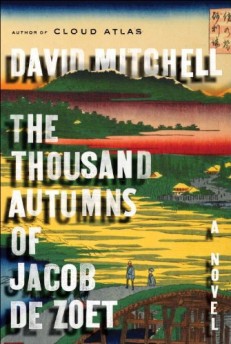 Reviewed:
Reviewed:
The Thousand Autumns of Jacob de Zoet by David Mitchell
Random House, 496 pp., $26.00
David Mitchell’s The Thousand Autumns of Jacob de Zoet is his fifth and finest novel. And with a little patience, it’s also the ultimate summer read. It is a long, absorbing, and occasionally dizzying novel with an enormous cast of characters making their way across a wide swath of chronology and a tiny bit of land.
In Ghostwritten and Cloud Atlas, Mitchell pushed geographical limits and tied together a seemingly unrelated string of narratives. Although much lauded, these novels were too dependent on construct and coincidence. Number9Dream started strong, but lost itself in an unfortunate deluge of unrelenting subplots. Black Swan Green, more singular in focus, lacks the abundant richness offered in The Thousand Autumns of Jacob de Zoet, which marries complexity and coherency in a way Mitchell has never managed before. This is both his most fully realized and most accessible work. The title is somewhat misleading. It is not so much the story of Jacob de Zoet, but of two cultures and two groups of people colliding.
When de Zoet arrives at Dejima, a Dutch-constructed island-cum-trading post adjacent to Nagasaki, during the steamy summer of 1799, his “pale and freckled skin is frying like bacon.” His appearance is just one aspect that isolates him from those, both Japanese and Dutch, around him. In addition to his complexion, his position as an accounts auditor makes him unpopular and untrusted among his fellow Dutch. As the scion of a clerical family and the intended for a woman back home, he is forced to take the clerkship in an effort to appease his prospective father-in-law. De Zoet has a quiet and respectful temperament. He doesn’t gamble or drink. He has no friends to speak of, and the few people he does spend time with are transplants of a similar disposition. There is Marinus, the full-time curmudgeon and surgeon; Ogawa, the translator; and Orito Aibagawa, Marinus’ student, midwife of repute, and eventual love interest for de Zoet. The idea of transplantation is significant to the thread of medicine and healing in the narrative and to its emphasis on purity and cultural superiority.
The book’s many characters seem almost interchangeable, but are necessary additives in the ethnic stew Mitchell carefully prepares. The streets of Dejima teem with lecherous traders, swarthy sailors, wise healers, ambitious students, shrewd wives, and a manipulative monkey named William Pitt. Just outside of Dejima is a dark forest, a sinister mountaintop convent full of secrets, and a Japan of which the Dutch have no awareness. Dejima is their DMZ.
Mitchell imbues Dejima with a Dickensian depth, noting the stench of ordure carried by the wind, the crunching of ground underfoot, the portentous creaking of weathervanes, and the tinkling of a harpsichord with an attention wavering somewhere between glee and obsession. Dejima is where East and West meet, and where fortune is made and, for most of the novel, lost.
The story is set during the Tokugawa Shogunate, a feudal reign which lasted for more than 250 years. Mitchell distills the emotional and social volatility of the era, its regressive social customs and caste structure. Class allowed the corrupt to ascend, prevented the honorable from promotion, obstructed the truth, kept love from blossoming, and silenced the voices of women. The one element that transcends these obstacles, and unites these seemingly disparate characters and events, is the written word. Like Mitchell’s previous work, this novel isn’t just about the many guises of storytelling but the power, knowledge, and community gained from storytelling.
Towards the beginning of the novel, de Zoet writes that ink is the “most fecund of liquids.” From this fecundity, and with a bit of authorial alchemy, the use of books, scrolls, notes, letters, and illustrations opens up a hall of mirrors through which to view the events of the novel. As in Eliot’s Adam Bede, Mitchell uses “a single drop of ink for a mirror.”
By the end of the novel, de Zoet offers a thought about a Japan that he, Mitchell, and the reader are fascinated by but still struggle to understand. “This world, he thinks, contains just one masterpiece, and that is itself.” Mitchell’s novel, like Japan, is all encompassing and ever elusive.
Joshua Zajdman holds a B.A. in English, an M.A. in Literary and Cultural Studies, and a book at all times.
Mentioned in this review:
The Thousand Autumns of Jacob de Zoet
Cloud Atlas
Ghostwritten
Black Swan Green
Number9Dream

